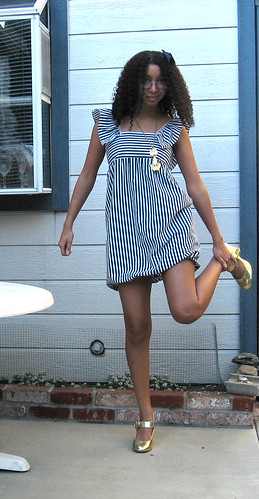
Before reading, see part 1: inspiration if you care.
So, you have an idea. But before you can implement it, you need to do some planning and pick up some supplies. I'll leave it to you to pick out you more project specific needs; I'm going to list useful items that are more general and you might not think about having around.
1. iron
An iron is a very good thing to have and use on your projects. Use it to iron your fabric before cutting, to iron seams, to set iron on adhesives, on your final product, etc. You can get by without an iron, but you'll be surprised by the difference an iron makes.
2. iron on adhesive or fabric glue
If you're not so good with the needle and thread, iron on adhesives and fabric glue are great alternatives to explore. They're also great tool if you can handle your needle and thread. Use it to hold fabric in place while you sew, make your own appliques, and a dozen other uses I'm sure you can come up with. I like to keep some iron on adhesive tape in my sewing kit, though I also keep a sheet or two on hand for appliques.
Also, if you plan on button holes, iron on interfacing is a good idea. It will keep your button holes from stretching, making them look nice and work better. It's also a good idea to help reinforce waist bands and support zippers on light fabrics.
3. straight pins
If you plan on doing a bit of diy, get yourself a pack of straight pins. They're cheap and very worth it. Safety pins, though I love them, are no substitute. Get the longer ones; they stay in the fabric better. Plus, you can use the straight pins to pin your fabric into your carpet or corkboard, which may come in handy for you later.
4. thread
Dollar store thread sucks. Get yourself some good quality thread. It may seem like it costs a lot, but good quality thread is sturdier (& therefore will last longer), looks nicer, and is not wrapped in a retarded style that makes it impossible to use on a sewing machine and annoying to handsew with. Also, get the big spool of thread, at least a 100 yds. You'd be surprised how quickly thread goes, especially if you use a sewing machine.
Selecting a Color: It's hard to match fabric colors to your fabric sometimes. I find that a thread that is a little darker than your fabric won't be as noticible and prominent as thread that is lighter. When you can't find a color even mildly close to your fabric, try selecting a color that just looks nice with your fabric. Also remember thread color doesn't really matter that much in most cases since it isn't visible on the outside. If you're still learning and prone to messing up, you might want to use a contrasting color in non-visible places. It makes picking on your foul stitches much easier.
5. needles
There is a reason for all the different sized needles. if you're using a sewing machine, make sure you have the proper needle for your fabric, especially if your fabric is really heavy or light. If you're hand sewing, the needles are different sizes for functionality. If you buy a pack of hand needles, they usually say what the different needles are for on the back of the package.
On this note, if you're using a sewing machine, make sure you have the right feet and the right needles for your project. The information you need should be in your sewing machine manuel.
6. Seam Ripper
It's my favorite tool. It's so useful when you mess up and need to rip out stitches, moving stitches when altering an item, and it just generally looks cool and hardcore in your sewing kit. They cost like a dollar and are totally worth it. Beware though; they're very sharp and you can stab yourself with them.
7. sewing shears
While they don't necessarily have to be sewing scissors, a good pair of sharp, strong shears could make all the difference in cutting a straight line, and a wierd, choppy line. If you're having trouble cutting you're fabric, buying a new pair of shears might help. Dollar store sewing scissors seem to be decent, but they also seem not to last for lengthy periods. The rotary cutters work even better at helping you get a straight line, but the sets are also kind of expensive.
Alright, that's all I can think of. Wonder around your local sewing store and investigate. You'll find cool embellishments you can use and maybe some products you didn't know were available. (Grommets and hooks & eyes come on tapes!)
The dress on this post was made from a twinsize fitted sheet. The bubble hem and straps are formed from the stretchy portions on the ends. Really sweet and simple. Click on the image for more info.
Arrives precisely when she means to plus 15 minutes,
Ivy Frozen

No comments:
Post a Comment